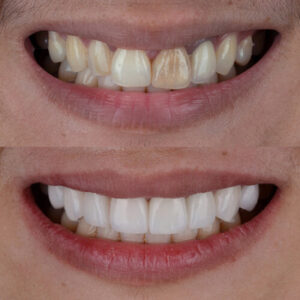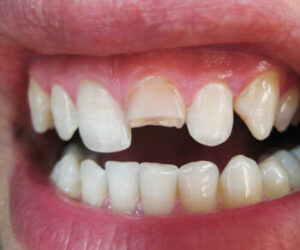If you’ve been considering dental veneers, you might wonder, “Can you eat with veneers?” This is a common question for many people contemplating this popular cosmetic dental procedure. Veneers, particularly porcelain veneers, can transform your smile by covering imperfections like misshapen teeth or discolouration. But what about the practicalities of day-to-day life, like eating? Let’s dive into the details to uncover how veneers fit into your dining habits and what changes you might need to make.
What Are Porcelain Veneers, and How Do They Work?

There are different types of veneers, such as permanent veneers, temporary veneers, and composite veneers. Permanent veneers, often made from porcelain, are known for their durability and natural appearance. In contrast, temporary dental veneers, sometimes used as a stopgap before permanent veneers are applied, are less sturdy and are fixed with temporary cement.
The First Few Days: What to Expect After Getting Veneers
So, what can you expect immediately after getting veneers? Once your dentist has applied your veneers, particularly temporary ones, you might need some time to adjust. Wearing temporary veneers may initially feel slightly strange, but most patients quickly get used to the feeling.
At first, you may be recommended to eat only soft foods like yoghurt, mashed potatoes, or soup. This gives the veneers time to bond firmly to your natural teeth without the risk of them coming loose. Avoiding hard foods or sticky foods is crucial during this period to prevent damaging your veneers or dislodging the bonding material.
Eating with Permanent Veneers: Freedom with a Few Cautions
Once you’ve transitioned to permanent porcelain veneers, the food world largely opens back up. Porcelain veneers are extremely durable and designed to handle the rigours of daily life, including eating a wide variety of foods. However, even with their durability, there are some guidelines to follow to keep your veneers in optimal shape.
Foods to Enjoy and Foods to Avoid
- Enjoy: With veneers, you can still enjoy most of your favourite foods. Soft foods like pasta, chicken, and steamed vegetables are perfectly safe. Moderately hard foods such as apples or carrots can also be eaten, but cutting them into small pieces is a good idea to avoid putting excessive force on your veneers.
- Be Cautious With: Some foods and drinks require a bit more caution. Hard foods like nuts, bone-in meats, raw fruits and raw carrots can be risky if bitten directly with the front teeth. Sticky foods like toffee can also pose a problem as they might pull on the veneer.
- Avoid: Hard candies, ice cubes, and foods that require excessive chewing should be avoided. Biting into these can cause damage to both veneers and natural teeth. It’s also best to avoid dark liquids like red wine, coffee, and black tea as they can stain the veneers over time, much like they do natural teeth.
How to Protect Your Veneers: Good Habits to Keep
Maintaining your veneers is about adopting good habits and practising good oral hygiene. Here are some tips:
Chew Carefully
While veneers are strong, they aren’t indestructible. Try not to use your front teeth to bite into hard foods. Instead, use your back teeth, which are better suited for this purpose.
Avoid Excessive Force
Habits like chewing on ice cubes, hard candy, or even your nails can apply unnecessary pressure to your veneers, increasing the risk of chips or cracks.
Be Mindful of Staining
While porcelain veneers are resistant to stains, over time, exposure to dark liquids like coffee, tea, and red wine can lead to discolouration, especially around the edges where the veneer meets your natural tooth. Brushing after consuming these beverages can help reduce staining.
Veneers and Everyday Beverages: What Should You Know?

Veneers and Special Foods: Steak, Chicken, and Beyond
Many patients ask, “Can you eat steak with veneers?” The answer is yes but with caution. Eating steak or other tough meats is possible, especially when cut into smaller, manageable pieces. Using your back teeth to chew will help distribute the pressure more evenly and protect your veneers.
Eating chicken, especially if it’s boneless, is generally safe. Just be sure to avoid biting directly into bone-in meats, as bones can damage your veneers or even your natural teeth.
Caring for Your Veneers: Long-Term Tips
Proper care is critical for preserving the longevity of your veneers. This includes regular brushing and flossing, much like you would with your natural teeth. A non-abrasive toothpaste is best to avoid scratching the surface of the veneers.
Routine dental visits are crucial. During these check-ups, your dentist will assess the condition of your veneers, verify that the bonding material is secure, and perform professional cleanings to maintain the health of both your veneers and natural teeth.
FAQs About Eating with Veneers
- Can I eat normally with veneers?
Yes, you can eat most foods normally with veneers. However, to prevent damage, it’s best to avoid biting into extremely hard or sticky foods directly with your front teeth.
- Will veneers stain like natural teeth?
Porcelain veneers are more resistant to staining than natural teeth, but they can still discolour over time if they are frequently exposed to dark liquids like coffee, red wine, and tea.
- Can I chew gum with veneers?
Yes, you can chew gum with veneers, but it’s recommended to choose sugar-free gum and avoid chewing excessively to prevent wear on the veneers.
- Are there any foods I should avoid completely?
It’s wise to avoid very hard foods like ice cubes and hard candies and sticky foods like caramel, as these can chip or loosen the veneers.
- How should I care for my veneers after eating?
After eating, especially foods that can stain, rinse your mouth with water and maintain proper oral hygiene by brushing and flossing regularly. This helps keep both your veneers and natural teeth healthy.
Final Thoughts: Veneers and Your Diet

With these simple adjustments, you can enjoy your new smile without making significant changes to your diet. Veneers provide a beautiful, natural-looking solution for a radiant smile, allowing you to confidently eat, drink, and smile.
For more information about getting veneers or if you have any questions, feel free to contact Dental 266. Our friendly team is here to help!Call Dental 266 at 02 9051 0600.
References:
WebMD. (n.d.). What are veneers? Retrieved from https://www.webmd.com/oral-health/veneers
Crest. (n.d.). 20 foods and drinks that stain your teeth. Retrieved from https://crest.com/en-us/oral-care-tips/teeth-stains/20-foods-and-drinks-that-stain-your-teeth/
Cleveland Clinic. (n.d.). Oral hygiene. Retrieved from https://my.clevelandclinic.org/health/treatments/16914-oral-hygiene






